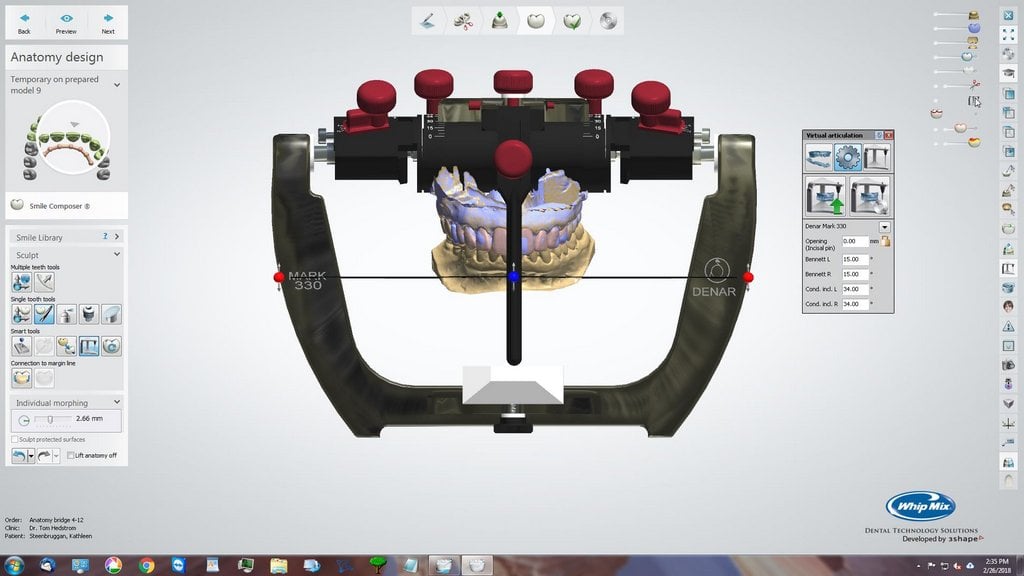 Although temporomandibular joint (TMJ) disorder commonly refers to jaw pain, most patients are unaware of the vastness of its causes, signs, and symptoms. TMJ disorder can be caused by dental treatments, trauma, lifestyle habits, stressful social situations, and emotional factors.1 These causes lead to a variety of symptoms, including neck, jaw, face, or shoulder pain; limited range of motion; and headaches. However, these symptoms can also be caused by several other problems, including bruxism, stress, teeth grinding, and improper alignment. By asking specific questions about jaw and head/face pain during each dental appointment, you can address these symptoms and determine whether or not a patient should be examined for TMJ disorder or another problem.
Although temporomandibular joint (TMJ) disorder commonly refers to jaw pain, most patients are unaware of the vastness of its causes, signs, and symptoms. TMJ disorder can be caused by dental treatments, trauma, lifestyle habits, stressful social situations, and emotional factors.1 These causes lead to a variety of symptoms, including neck, jaw, face, or shoulder pain; limited range of motion; and headaches. However, these symptoms can also be caused by several other problems, including bruxism, stress, teeth grinding, and improper alignment. By asking specific questions about jaw and head/face pain during each dental appointment, you can address these symptoms and determine whether or not a patient should be examined for TMJ disorder or another problem.
Early detection of TMJ disorder is essential to reducing its adverse affects on the joint and surrounding tissue.2 Patients may suffer from head and jaw pain without knowing the damage that the underlying cause can do to their joints. Asking questions can lead to patient awareness and early detection, which provides clinicians with the opportunity to prevent further TMJ damage and patient suffering.
TMJ disorder uniquely affects the temporomandibular joint, which is unlike any other joint in the body. While it is still unclear exactly what causes TMJ disorder, TMJ degeneration manifests from an imbalance of matrix synthesis and degradation, which are controlled by chondrocytes and fibrochondorocytes in the cartilage and fibrocartilage of the TMJ.2 Degeneration of the joint leads to orofacial pain in a variety of places, including head, neck, jaw, face, shoulders, or arms.
A study published in 2002 examined the orofacial pain in patients at a general medical practice in England. With a sample size of more than 2500 patients, 25.8% of them reported some orofacial pain.3 In the United States, approximately 10 million Americans also suffer from orofacial pain.4,5 Therefore, discussing head and jaw pain during a routine dental appointment provides the ideal time for developing patient pain management strategies and awareness. Additionally, determining the type of pain and its source helps to narrow down the optimal minimally invasive treatment plan.
Such plans can incorporate deprogrammers, which provide a conservative treatment option that works to alter the masticatory muscles back into a balanced state. By retraining the muscles, deprogrammers relieve pressure and alleviate muscle and/or jaw pain. Without invasive treatment, deprogrammers work within the boundaries of the patient’s current dentition to relieve pain almost instantly. Deprogrammers are also useful for treating other problems, including snoring, head pain, and imbalanced occlusion.
Head health questions at every appointment encourage clinicians and their patients to regularly explore any head pain the patient may experience and its potential connection to TMJ disorder. Additionally, patient awareness proves important as some patients are unaware that dental professionals treat head pain, while other patients believe their head pain is normal and are unaware of treatment options. Initiating a discussion about head pain increases communication and trust between clinicians and patients. With a large number of Americans suffering from orofacial pain, questions regarding head pain and jaw pain enable clinicians and their patients to better understand and more effectively treat their condition.
Questions to ask patients about head and jaw pain:
- Do you have pain in your head, neck, shoulders, arm, or jaw? Is this pain worse in the morning?
- Do you regularly get severe headaches or migraines? If yes, how frequently?
- Do you experience regular mild headaches? If yes, how frequently?
- Do you experience difficulty when opening your mouth?
- Do you hear any clicking or noises in your jaw joints?











.png)

Leave a comment